Page path:
- Departments
- Department of Biogeochemistry
- Biogeochemistry Group
- People
- Research Projects
Research Projects
MARUM Cross-Cutting Project 5
The role of hydrodynamics and morphodynamics in organic matter mineralization and nutrient turnover in permeable sandy sediments
Sediment properties, hydro- and morphodynamics constitute the physical boundary conditions of biogeochemical processes in sandy sediments. Bottom water currents and sediment transport are highly variable in coastal waters causing variable advective porewater transport within permeable sediments. The resulting redox conditions are expected to be also highly dynamic with so far unknown consequences for the rates of benthic carbon mineralization and nutrient turnover.

The project combines the measurement and mathematical modeling of physical parameters such as current velocities, sediment transport, and porewater flow with biogeochemical rate measurements to understand and quantify carbon mineralization and nutrient turnover under highly dynamic conditions - a prerequisite for a sound mass balance analysis.
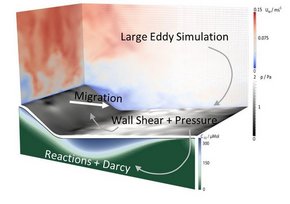
Multiphysical modeling combining Large Eddy Simulation, Darcy Flow and Reaction Rates. Ripple migration as a function of shear stress and sediment grain size is implemented.
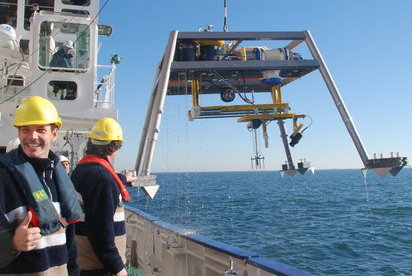
A new Lander System for in situ measurements combines current velocity measurements (ADCP), optical topography scanning of the sea bed and parallel oxygen profiling in underlying sediments using fast responding optodes.
Previous projects
HYPOX – In situ monitoring of oxygen depletion in hypoxic ecosystems of coastal and open seas, and land-locked water bodies (EU 7th framework program)
Hypoxic (low oxygen) conditions in aquatic ecosystems increase in number, duration and extent due to global warming and eutrophication. Global warming will lead to degassing of oxygen, increased stratification, reduced deep-water circulation and changes in wind patterns affecting transport and mixing. Projected increases in hypoxia (e.g. doubling of “dead zones”) are accompanied by enhanced emission of greenhouse gases, losses in biodiversity, ecosystem functions and services such as fisheries, aquaculture and tourism. Hypox monitors oxygen depletion and associated processes in aquatic systems that differ in oxygen status or sensitivity towards change:
• open ocean, oxic with high sensitivity to global warming (Arctic),
• semi-enclosed with permanent anoxia (Black Sea, Baltic Sea) and
• seasonally or locally anoxic land-locked systems (fjords, lagoons,
lakes) subject to eutrophication.
• open ocean, oxic with high sensitivity to global warming (Arctic),
• semi-enclosed with permanent anoxia (Black Sea, Baltic Sea) and
• seasonally or locally anoxic land-locked systems (fjords, lagoons,
lakes) subject to eutrophication.
Part I: Oxygen variability in the benthic boundary layer
As part of the Hypox project the oxygen variability in the benthic boundary layer (BBL) is investigated. Sediments that intersect with the pycnocline of the water column are often exposed to highly variable oxygen concentrations. The availability of oxygen depends on the vertical displacement of the chemocline as well as on concentration gradients caused by benthic consumption and reduced turbulent transport in the stratified BBL. To disentangle the drivers for varying oxygen concentrations in the bottom water, vertical gradients of oxygen and density have to be measured in the BBL. This was done with the BBL-Profiler (see Fig. 1+2)
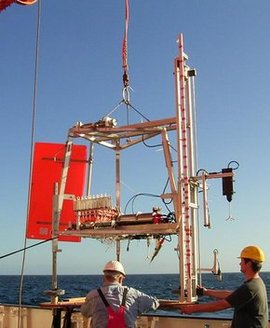
Fig. 1 (left side): The BBL-Profiler is an automatic sampling device that is deployed to the seafloor for several hours. It can be equipped with several sensors such as CTD, Acoustic Doppler Velocimeter (ADV) and optodes to measure salinity, temperature, oxygen and current velocities profiles in the benthic boundary layer. A 12 channel peristaltic pump collects samples within the first 2m above the sediment to measure nutrient profiles.
Fig. 2 (below): The BBL-Profiler was used to measure the variability of oxygen concentrations gradients in the bottom water of the Crimean shelf (Black Sea) over a time course of 7 hours. The high variability was assigned to the vertical shift of the oxycline.
Fig. 2 (below): The BBL-Profiler was used to measure the variability of oxygen concentrations gradients in the bottom water of the Crimean shelf (Black Sea) over a time course of 7 hours. The high variability was assigned to the vertical shift of the oxycline.
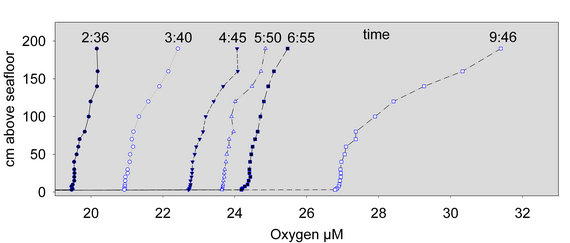
Part II: Mixing of oxic and anoxic waters
In aquatic systems with frequent or permanent anoxia, such as the Baltic Sea, the Black Sea or enclosed fjords, strong mixing of anoxic and oxic waters occurs predominantly where the oxycline intersects with the sediment or during inflow events that inject oxic water into anoxic layers. The impact of mixing events on the biogeochemical cycling and on the microbial community is not well studied yet. In the south western Black Sea, saline, oxygenated Mediterranean water leaves the Bosporus Strait and is mixed into the anoxic waters of the Black Sea. We used a newly built Pump-CTD (Fig. 3) to obtain high resolution nutrient profiles cutting these Bosporus plumes. The plume waters are characterized by increased oxygen concentrations and exhibit significant alteration of fixed nitrogen and sulfide inventories. Incubations with added 15NO3- indicate high capacities of denitrification in Bosporus Plume waters in contrast to adjacent sulfidic waters.
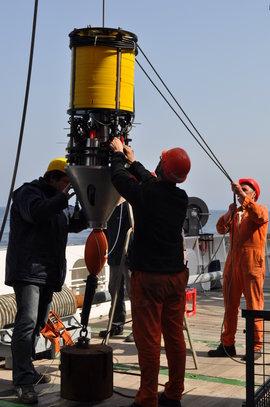
Fig. 3: The newly built pump-CTD with additional oxygen and turbidity senor. Here, the pump-CTD was used as a free-falling system. During the descent through the water column, the pump supplies the ship's laboratory with water samples for nutrient measurements. High resolution nutrient profiles down to 300m can be realized.
Marum Project GB2
Marum Project GB2: N/P/Fe-biogeochemistry in Benthic boundary layer and surface sediments
The availability of nutrient N, P, and Fe limits primary productivity in the ocean, and variations in their relative abundance affect the species composition of phytoplankton communities in surface-waters. Project GB2 investigates the fate of these nutrients in the ‘Benthic Boundary Layer’ (BBL), the lower 2-3 m of the water-column. Little is known about the bio-geochemical and geomicrobial processes controlling the abundance of nutrient N, P, dissolved organic matter (DOM), and Fe in the BBL. The BBL is the transition zone for particulate OM sinking down from surface waters to the sediment and for dissolved species of N, P, and Fe diffusing out of the sediment into the water column. Water column mixing will eventually return these nutrients back into surface-waters. The BBL thus intimately links fluxes of N, P, and Fe from surface sediments to primary production in the ocean.
A specific hydrodynamic property of the BBL is the rapid change of turbulent diffusivity close to the sediment causing increasing concentration gradients of nutrients and oxygen in the BBL. As part of the MARUM Project GB2, we use the BBL-Profiler (Fig. 1) to obtain high-resolution profiles of oxygen and nutrients in the BBL (Fig. 5). Based on these profiles the exchange rates of e.g. oxygen and fixed nitrogen between the sediment and the water column can be estimated in a non-invasive way. In the Baltic Sea, for instance, these rates give an O2:N ratio of 17:1, which is far above the Redfield ratio of 7:1 and suggests heavy nitrogen loss from the sediment, probably due to denitrification.
A specific hydrodynamic property of the BBL is the rapid change of turbulent diffusivity close to the sediment causing increasing concentration gradients of nutrients and oxygen in the BBL. As part of the MARUM Project GB2, we use the BBL-Profiler (Fig. 1) to obtain high-resolution profiles of oxygen and nutrients in the BBL (Fig. 5). Based on these profiles the exchange rates of e.g. oxygen and fixed nitrogen between the sediment and the water column can be estimated in a non-invasive way. In the Baltic Sea, for instance, these rates give an O2:N ratio of 17:1, which is far above the Redfield ratio of 7:1 and suggests heavy nitrogen loss from the sediment, probably due to denitrification.
Fig. 5: In the Baltic Sea, the BBL-Profiler was used to measure concentrations of dissolved oxygen and fixed nitrogen species (ammonium, nitrate and nitrite) across the BBL (left column) . From these profiles, exchange rates of oxygen vs. fixed nitrogen can be calculated (right column).